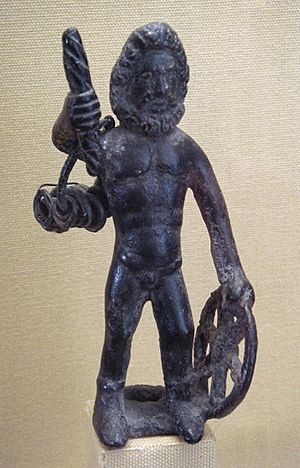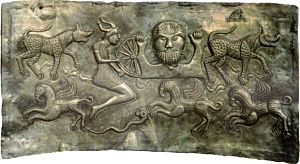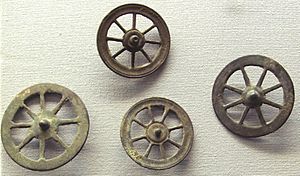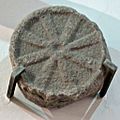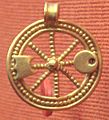Taranis facts for kids
In Celtic mythology, Taranis was a powerful god of thunder. People mainly worshipped him in areas like Gaul (modern France), Hispania (Spain and Portugal), Britain, and Ireland. He was also known in parts of Germany and along the Danube River.
The Roman poet Lucan wrote about Taranis in his poem Pharsalia. Lucan mentioned Taranis along with other Celtic gods, Esus and Toutatis. Taranis was often linked to the wheel, much like the Cyclops Brontes ("thunder") in Greek mythology.
Many ancient carvings and statues found in Gaul show a god with a beard, holding a thunderbolt in one hand and a wheel in the other. This god is thought to be Taranis. Over time, people started to see him as similar to the Roman god Jupiter, who was also a god of thunder.
Contents
What Does the Name Taranis Mean?
The name Taranis comes from an older Celtic word, *Toranos, which means 'Thunder'. This word itself comes from an even older language, Proto-Indo-European, where the root word meant 'to thunder'.
We can see this ancient root in other names and words. For example, an old name for the River Po in Italy was Tanarus, meaning 'thundering' or 'thunderous'.
Taranis and Other Thunder Gods
The name *Toranos is very similar to the name of the Proto-Germanic thunder god, *Þun(a)raz. This is where we get the names for famous gods like Thor (from Old Norse Þórr) and Donar (from Old High German Donar).
This connection shows that many ancient cultures had similar ideas about a powerful thunder god. The Celtic and Germanic names for their thunder gods might have come from a shared, very old name for a thunder god in the Proto-Indo-European language.
Taranis in Other Celtic Languages
The name Taranis also appears in other Celtic languages. For example, in Old Irish, the word for 'thunder' is torann. In Middle Welsh, it's taran. These words all show how the idea of 'thunder' was linked to this powerful god.
Why is Taranis Linked to the Wheel?
The wheel, especially a chariot wheel with six or eight spokes, was a very important symbol in ancient Celtic religion. This symbol was often connected to a specific god, known as the "wheel-god." This god was seen as a god of the sky, the sun, or thunder. We know from the Roman poet Lucan that this god was Taranis.
Many ancient Celtic coins also show this wheel symbol. Even on the famous Gundestrup cauldron, there's a panel with a "broken wheel" that has eight spokes.
Wheels as Offerings and Amulets
People would offer symbolic wheels at holy places, like the ancient city of Alesia. They would also throw them into rivers, like the Seine River. Sometimes, these small wheels were buried in tombs or worn as amulets (lucky charms).
These "wheel pendants" from the Bronze Age often had four spokes. They are usually thought to be symbols of the sun or "sun crosses." The idea of the Sun being like a wheel or a chariot is found in many other mythologies, including Germanic, Greek, and Vedic stories.
See Also
- Delbáeth
- Fontes Tamarici
- Perkūnas
- Indra
- Perun
- Thor
- Tuireann
- Zeus


